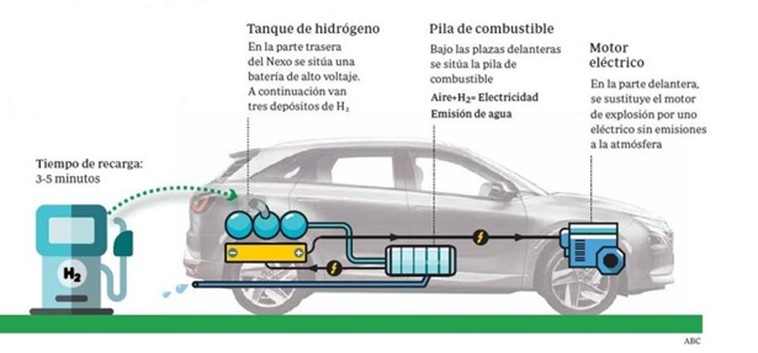
The phasing out of combustion engine vehicles, whether petrol, diesel or hybrid, is a fact that will happen in the near future. It will depend on countries’ commitments.
In the case of the European Union, they are committed to transforming Europe into a highly energy-efficient, low-carbon economy. In fact, the European Commission expects hydrogen to account for 13-14% of the EU’s energy mix by 2050. We discussed this in detail in a previous post. Spain, has worked on a recovery plan in which it will allocate 13.2 billion euros to sustainable and connected mobility. In November 2020, the government announced its intention to allocate more than €1,500 to the development of hydrogen over the next three years.
Related to the transport sector, which is responsible for more than 25% of global emissions, we have seen it with the electric car and now we are starting to see it with the hydrogen-powered car. What will be the alternative to petrol?
The next decade looks set to be a turning point in the automotive sector, electrification is the way forward for greener mobility, but is this the only way forward? What about hydrogen vehicles?
These are cars that run on an electric motor, but in this case the battery that drives the motor is not charged with electricity, but with hydrogen. Its footprint on the environment is almost invisible as it emits water vapor, takes less than five minutes to refuel and has a longer range as it is not powered by a battery.
How would it work? A vehicle stores hydrogen in several tanks to feed the fuel cell, where oxygen is injected to create a reaction that generates electricity that goes directly to the battery and water vapor.

Image: Hydrogen fuel cell vehicle mechanism. Source: ABC.
Hydrogen is not a primary energy source like coal or natural gas that is extracted from a deposit, but a chemical product, a gas used in industry to refine gasoline among others (there we explain the details). Therefore, it depends on a generation infrastructure and, as of today, there are only 432 hydrogen stations in Europe and Asia, a practically non-existent presence compared to its competitors.
The supply infrastructure is key to reaching the automotive industry. This involves not only producing the fuel itself, but also the pipes to transport it, as well as the development of fuel cells. A key component is high quality steel pipes, which will be an important requirement for companies that will need flexible solutions to help them install refuelling stations where they are needed.
The truth is that both electric and hydrogen fuel cell cars are potentially a clean form of transport, but to be truly environmentally friendly we will have to move away from fossil fuel methods of electricity production. We should not forget that, at present, around 96% of hydrogen is generated from fossil fuels.
Neither is the battery treatment process viable at the present time; the extraction of lithium is a major ecological problem, but also the recycling of batteries. On the fuel cell side, its components do not pollute, but they are difficult to find, such as platinum.
Below, we summarize the main pros and cons of hydrogen fuel cell vehicles:
Cons
- The starting price is higher than that of an electric car, with an average price of € 60,000 versus the € 26,000 that an electric car can cost. This is due to less supply and little or no competition.
- A hydrogen fuel cell has a consumption of 29 KWh/100 km, almost twice as much as an electric vehicle, which consumes 14 KWh/100 km.
- In Spain there are currently 6 refuelling stations and they are experimental, compared to the 8,000 electric filling stations and recharging points of all kinds of power.
- Whether it pollutes or not depends on the origin of the energy used. If it is produced with water, it is expensive, and if it is produced with sun or wind, it loses efficiency in the process. That is why so far it has been generated by natural gas, so it is no longer a green alternative.
Pros
- More sustainable as it purifies the air, its emissions are water vapor. An electric car emits on average 108g of CO2 per km.
- More autonomy, almost 800 km with a 5-minute charge. (with an electric car we would only have 125 km).
- The weight of its components is lighter, which can help power hydrogen in large vehicles, which need to limit weight so as not to penalize the payload.
- Shorter refueling time, almost as fast as a combustion engine
So, what is the barrier to earlier investment in this technology?
The main barrier is that the market is not mature and that, at present, it is not an economically viable alternative. The good thing about hydrogen is that it has the advantages of the combustion car and the advantages of the battery electric car, but with some disadvantages.
However, without government support, setting up a network of “hydrogen plants” seems complex, as without cars to supply there is no business, and without business, there is no private investment. Moreover, the slowdown caused by the lack of infrastructure, coupled with other disadvantages such as the high cost of hydrogen cars at the moment, mean that battery electric cars are currently at an advantage. Even so, the battle promises to be interesting, and it may even be that in the coming years both technologies will end up coexisting.
If you found it interesting, please share it!
Recent Articles



































